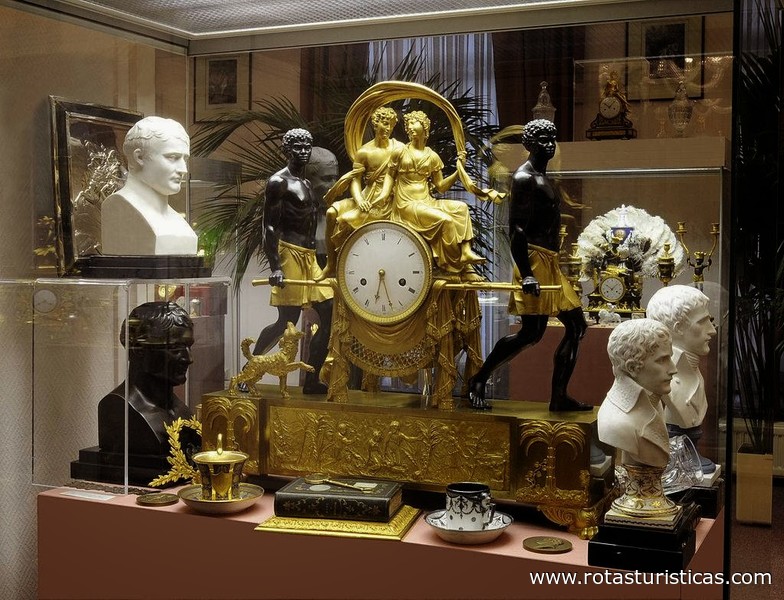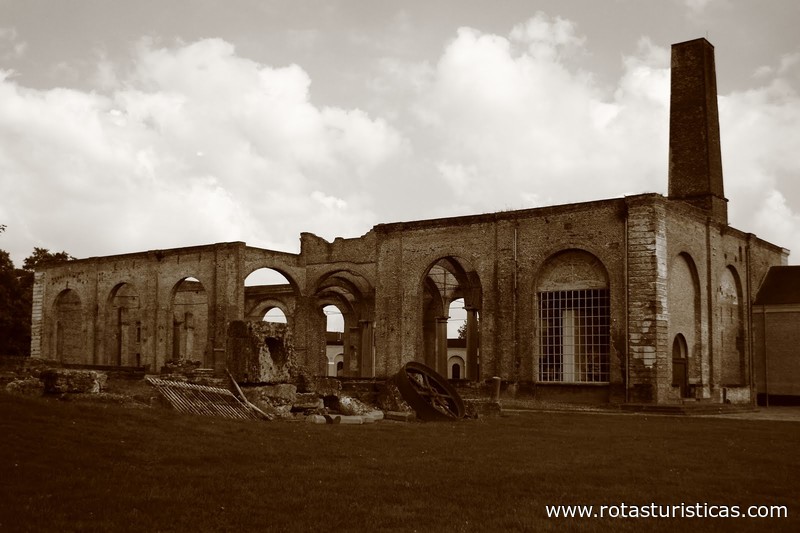Bruxelas, Brussels, Belgium
Suggest Place to Visit
2020
Track to location with GPS |
 |
Le Grand-Hornu is a former industrial coal mining complex belonging to the municipality of Hornu, located in the Borinage region, one kilometer of kilometers east of the center of Mons, in Hainaut in Belgium. It is part of the major heritage of Wallonia. In a neoclassical style, I compose the same with the beautiful architectures of the industrialist and composed of more than one list of people.
The site was inscribed on the World Heritage site in 2012 during the 36th session of the World Heritage Committee.
Charles Sébastien Godonnesche, "general farmer of the grants of the city and suburbs of Valenciennes", in association with two Borains, obtained on January 19, 1778, from the abbey of Saint-Ghislain, the right to exploit the coal seams of links the concession of the seigneury of Quaregnon to the cellar of Boussu. The financial difficulties and the problems of exploitation multiply and, on the death of Godonnesche in 1810, his widow, Marie Antoinette Félicité Lemercier, sells the concession to Henri De Gorge, a wealthy merchant from Lille.
Henri De Gorge (1774-1832), a total look at production, obtaining the extension of the concession, source of new wells and development of sales thanks to the excellent geographical location of the site, on a railway junction. After the erratic races, I achieved success following the digging of the fifth well in 1814, which allowed me to explore the excellent canapes of coal. Since 1816, the decor of a large architectural project that encompasses a modern style capable of drawing and maintaining one in three main mobile style.
First, trust the Lille architect François Obin in the realization of your visionary project. On his death in 1825, the project was taken over by the Tournai architect Bruno Renard. The latter, from a wealthy family, and a student of the architects of the Empire Charles Percier and Pierre Fontaine and undoubtedly watched in Paris the work of Claude-Nicolas Ledoux published in 1804, which includes a description of the evolution dream of the Royal Saltworks of Arc-et-Senans.
Work was completed for the commissioning of the famous machine room in 1831. Moreover, between the ages, De Gorge had to face a violent backlash hearing in 1830, during which his house and the industrial installations are looted. Died of cholera in 1832.
The proceeds of the concession for 120,000 tons of coal for an amount of 1,500 people. The widow De Gorge, Eugénie Legrand, reprimands the management of the coalmine by bequeathing it to her nephews who constitute a civil society.
The operation was arrested in 1954 following measures taken by the ECSC (European Coal and Steel Community). After the liquidation, the assembly of the dwellings of the sale of more often to the inhabitants of the dwellings, plus the site of the coal mine remains abandoned several years. In 1969, I was the subject of a royal decree leading to demolition.
The site was completed in 1971 by an architect from Hornu, Henri Guchez, who has since renewed and restored the site.
In 1984, the Province of Hainaut created the Grand-Hornu Images association, to manage and run the site. The province eventually bought the entire site as well as the Chateau De Gorge in 1989 with the aim of making it a cultural and seminar venue. At the same time, Grand-Hornu Images is developing an exhibition policy oriented towards design and the applied arts that makes Grand-Hornu one of the European places of reference for the demonstration of these disciplines.
After 2002, the complex welcomes the Museum of Contemporary Arts of the Wallonia-Brussels Federation (MAC's), installed in the basement of the newly restored by architect Pierre Hebbelinck.
Château De Gorge hosts a training center for new technologies.On the occasion of the bicentenary in 2010, the Grand-Hornu site, which was part of the Major Heritage of Wallonia, contributed, along with three other mining sites. major cities of Wallonia (Blegny-Mine, Bois du Cazier and Bois-du-Luc), the candidacy for UNESCO World Heritage.
The file, examined in July 2010, was postponed for additional information; reintroduced in early 2010, it was re-examined in 2012 by UNESCO, which was to be recognized by the universal property and respected by current sites. The site was reconnected on July 1, 2012, along with three other mini-sites in Wallonia.
There are several elements:
Central industrial installations: this is the heart of the company and its architectural heart. Organizations around a large oval courtyard, itself enclosed in a large quadrilateral, include the machine building workshop (for steam engines in mines), various studios and stores, an iron and copper foundry, a four with coke, the lamp, stables, a hay masin as well as an administrative building (called "House of engineers").
In 1854, the statue of Henri de Gorge was installed in the central courtyard. In 1927, a mausoleum was laid out on the way to a crypt to house his tomb and those of around twenty members of his family. The whole is surmounted by a Christ on the cross. These buildings have been completely restored.
West side of the old industrial complex called Grand-Hornu.
The workers' city: built mainly from 1822, it includes 425 houses in total, installed on long streets (up to 6), straight lines and sidewalks. They almost enclose the complement to the power plants. Each house has a bread oven, a water point and a garden. All these houses are, until 1954, identical, with the exception of the houses of the foremen (or foremen). The mine of the mine was recovered from the city. The facades were yellow with a black embellishment. Only one house, located rue de Gorge, retains this decoration. The rent consists of the time in a deduction of one day from the weekly salary. Collective facilities available to minors: a school (compulsory for children under 12), almost free hospital (no longer present, at the current location of the shopping center), a village hall, green spaces (place Green, place where a bandstand is developing). Sur and there are 2,500 inhabitants in 1829.
The Château de Gorge, found in 1832 (after the owner's death), is never usual. It served above all as a place of welcome during prestigious visits, such as those of the King of the Belgians Leopold I in 1832 and 1854.
The extraction pits, dark between 1778 and 1843, from 12 to 12, spread all around the city and most of them bear the names of saints, taking the first names of the women and daughters of the bosses of the coal mining. They reach a maximum depth of 998 m. At the time, the coal from the various wells was gathered on the esplanade, sorted before being sold in Belgium and France. There is hardly any trace of these pits, sin the slag heaps (those of pits 9 and 12) and a few firedamp outlets.
Comments
We don´t have yet any comments about:
Grand Hornu
Grand Hornu
Be the first to leave a comment as it is very important to inform other people
Outros locais a visitar
Within a radius of 20 km from:Grand Hornu
Decorative Arts Museum Francois Duesberg |
| 7,9 Km |
 |
Hotel reservation near Grand Hornu within a radius of 20 km
No results
Why to book with CLUBE TRAVEL
The best prices
Our partnerships with the world´s largest operators offer research on the best market prices.
More options
At Rotas Turisticos you can book the hotel, buy the air ticket, book the transfer from the airport to the hotel and vice versa, book the local excursions, rent the car, take travel insurance and consult the places to visit and where to go.
Holiday Tips & Destinations
Hundreds of holiday destinations with all the options that allow you to easily choose the destination that best suits your dream vacation.
CLUBE TRAVEL
Links





